
St. Nahi is an 18th-century church in Dundrum, Dublin, Ireland.

St. Nahi is an 18th-century church in Dundrum, Dublin, Ireland.
The name Taney derives from Tigh Naithi meaning the house or place of Nahi, and who may also be associated with Tobarnea, a seashore well near Blackrock. The current church is still in use by the local Church of Ireland community and is one of two churches in the Parish of Taney (historically encompassing the whole area around Dundrum). It is built on the site of an early Irish monastery founded by Saint NahÍ.
St. Nahi's stands on the grounds of the original monastery, having been refurbished several times, most recently in 1910, after a period when it was in use as the parish boys' school. Following storm damage to the roof, a major refurbishment was carried out by the then Rector of the Parish, Canon William Monk Gibbon (father of the poet of the same name), who is buried in the grounds of the church. A plaque erected after the refurbishment reads:
The entrance gate to this Churchyard was erected by the parishioners of Taney Parish to the memory of William Monk Gibbons, Canon of Christ Church Cathedral by whose impression and effort the restoration of this church was accomplished. He repaired the altar of the Lord.
The church contains some interesting artefacts including the baptismal font of the Duke of Wellington who was baptised in 1769, donated to Taney Parish in 1914 by the closing of St. Kevin’s Church in Camden Row, and altar tapestries depicting scenes from the Bible. The tapestries illustrating the Last Supper were made by the two Yeats sisters Lily and Lolly Yeats, both of whom are interred in the graveyard.
Two Rathdown Slabs [1] are displayed inside the church. These ornate burial slabs date back 1,000 years to the Viking-Christian era. Such slabs have only been found in the barony of Rathdown (the area roughly covering Churchtown to Bray). Only about 30 of these slabs have been discovered to date, these two were discovered in 2002 in the graveyard by archaeologist Chris Corlett, who had missed his bus from Dundrum and decided to explore the cemetery. [2] Local historian John Lennon, as well as Harry Griffith, aided by Dúchas, relocated the slabs inside the church. Harry Griffith has been researching and listing the graves in St. Nahi's graveyard since 2001, compiling a comprehensive history and listing of the graveyard. Harry Griffith was interred in the graveyard after an illness on 18 April 2012.
An insight into life expectancy for the area can be gleaned from the "Index to the Register of Burials" for the parish between January 1897 and April 1917 show 1,836 people buried during this period, of which 551 were children under 6 years of age.

Cremated remains are interred to the left of the entrance gates. This area was originally used for patients of the Dundrum Central Mental Hospital. Old records refer to this area as the Asylum Plot.
A back gate to the church was only recently uncovered under much overgrowth. Although it had been used by teachers as a shortcut between the Church (when it was being used as a boys' school) and the nearby girls' school, its original function is said to have been as an entrance for Roman Catholics when attending funerals at a time when they were barred from entering the main gates of a Protestant church.
Many Irish Republican graves lie within the graveyard, including the gravestones of Lorcain McSuibhne, a member of the Irish Republican Army killed in 1922 in Kildare (his funeral occurred at St. Nahi's and there exists photographic evidence of Éamon de Valera in attendance) and of James Burke, who was killed in Croke Park on Bloody Sunday.
The graveyard also contains many Royal Irish Constabulary Officers and Freemasons. There is one War grave. Sgt. William Anthony Kavanagh, RAF Volunteer Reserve, age 24, died 23 Sep 1944 as a result of a cycling accident while home on holiday, son of William and Mary Kavanagh of Balally. The site also contains the grave of the Irish physicist George Johnstone Stoney, who died in London in 1911. His ashes were brought back to be with his wife, mother and sister. His cousin Robert Stoney was a local curate when his wife died.
Currently, over 10,000 burials have been recorded, with the earliest visible gravestone dating back to 1734. The Parish of Taney: a History of Dundrum, Near Dublin, and its Neighbourhood [3] published in 1895, claims that there are "tens of thousands" of burials within the graveyard, a credible figure considering its age.
As the churchyard predates the disestablishment of the Church of Ireland in 1869, it is open for burial to all those who live within the boundaries of the Parish of Taney, whatever their denomination.
The organ of St. Nahi's was built by the renowned Irish organ-builder William Telford. However, St. Nahi's was not its original home. The organ was only installed there in the 1990s. The church used a harmonium (which is still there) to lead congregational singing. The organ has one manual, a pedal of limited compass and seven stops.
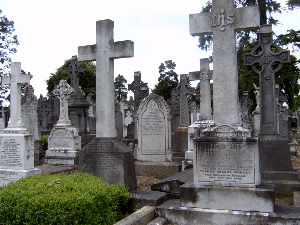
Glasnevin Cemetery is a large cemetery in Glasnevin, Dublin, Ireland which opened in 1832. It holds the graves and memorials of several notable figures, and has a museum.
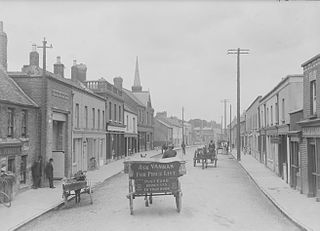
Rathfarnham is a southside suburb of Dublin, Ireland in County Dublin. It is south of Terenure, east of Templeogue, and is in the postal districts of Dublin 14 and 16. It is between the local government areas of Dún Laoghaire–Rathdown and South Dublin.

Dundrum, originally a village in its own right, is an outer suburb of Dublin, Ireland. The area is located in the postal districts of Dublin 14 and Dublin 16. Dundrum is home to the Dundrum Town Centre, the largest shopping centre in Ireland.

Churchtown is a largely residential affluent suburb on the southside of Dublin, between Rathfarnham and Dundrum.

Drumcliff or Drumcliffe is a village in County Sligo, Ireland. It is 8 km (5 mi) north of Sligo town on the N15 road on a low gravel ridge between the mountain of Ben Bulben and Drumcliff Bay. It is on the Drumcliff River, originally called the "Codnach", which drains Glencar Lake. Drumcliff is the resting place of the Irish poet W. B. Yeats. Drumcliff is in a civil parish of the same name.
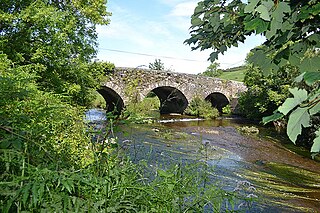
Ballylaneen is a small village and townland in County Waterford, Ireland, approximately halfway between the villages of Kilmacthomas and Bunmahon on a hill by the River Mahon. Ballylaneen is in a civil parish of the same name.

Kilmacud is a suburban area of Dublin in Dún Laoghaire–Rathdown, Ireland, at least partly contiguous with Stillorgan.

The Parish of Taney is a populous parish in the Church of Ireland, located in the Dundrum area of Dublin.

Rathmichael is a suburb south-east of Dublin, in the local government area of Dún Laoghaire–Rathdown, near the southern border of the traditional County Dublin. It is situated west of Shankill from which it is, roughly, separated by the M50/M11 motorways. It is also a civil parish in the barony of Rathdown.
Balally, County Dublin, Ireland, is a townland and residential area between Dundrum village and the Sandyford Industrial Estate in Sandyford.

Mount Jerome Cemetery & Crematorium is situated in Harold's Cross on the south side of Dublin, Ireland. Since its foundation in 1836, it has witnessed over 300,000 burials. Originally an exclusively Protestant cemetery, Roman Catholics have also been buried there since the 1920s.

William Dargan Bridge, opened in 2004, is a 162 metre cable-stayed bridge in Dundrum, Dublin, Ireland. It carries the Green Line of the Luas over the busy Taney junction, of the R112 and R117 regional roads as well as the little-known Slang River. The bridge connects rail alignments which were formerly part of the Harcourt Street railway line.
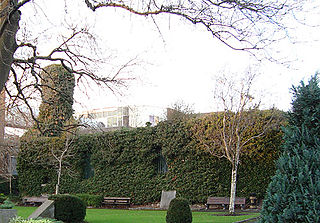
There was a St. Kevin's Church in what is now St. Kevin's Park, Camden Row, Dublin, Ireland at least as far as the 13th century. After the Reformation, it became an Anglican church. The original church was replaced around 1750 by a new one, closed in 1912 and now in ruins. Both churches were dedicated to Kevin of Glendalough. There is also a Catholic St. Kevin's Church a short distance away on Harrington Street.

The R112 road is a regional road in south Dublin, Ireland. It begins at the junction with the R148 road at Chapelizod and arcs southeastwards, then eastwards across the middle of south Dublin, ending at the Mount Merrion junction of the R138. The road is a single-carriageway, with cycle lanes on some stretches. Improvements to the road have been made over the last 10 years, the most significant being at Dundrum Cross where the road was widened to make room for the new Luas bridge and Dundrum bypass.
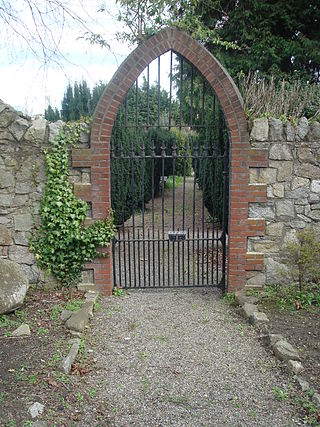
Carrickbrennan Churchyard located on Carrickbrennan Road, Monkstown, County Dublin, Ireland is a graveyard that can still be seen today, but is no longer in use. It is notable as the burial place of many people who perished in local maritime disasters. The graveyard stands beside the grounds of Monkstown Park, former estate of Lord Ranelagh and latterly the historian Charles Haliday, now used as rugby pitches by CBC Monkstown Park.

St Michael on Greenhill is a parish church in Lichfield, Staffordshire in England, located on the high ground of Greenhill east of the city. A church has been on the present site since at least 1190 but the current building was the structure from the restoration of 1842–43. The churchyard is one of five ancient burial grounds in England and is one of the largest churchyards in the country at 9 acres (36,000 m2).

Inis Cealtra, also known in English as Inishcaltra or Holy Island, is an island off the western shore of Lough Derg in Ireland. Now uninhabited, it was once a monastic settlement. It has an Irish round tower, and the ruins of several small churches, as well as four high crosses and a holy well. Despite the lack of population, the cemetery on this island is still in use. Coffins and mourners are transported the short distance from County Clare in small boats. Boat trips can be taken from the harbour at Mountshannon. It is conserved by the East Clare Heritage Centre.

St John's Church is located in St John's, Woking, England. The church is in the parish of St John's, Diocese of Guildford, which in turn is in the Province of Canterbury. The local village is named after the church.
The Central Mental Hospital is a mental health facility housing forensic patients in Portrane, Dublin, Ireland. The hospital, along with a community day centre for outpatients at Usher's Island, forms part of the National Forensic Mental Health Service.

St Boniface's Church, Papa Westray is a historic church and graveyard located on the island of Papa Westray in Orkney, Scotland. The site of the church dates back to the Iron Age and was possibly used later as a Christian monastery. The present church was built in the 12th century and was remodeled in 1710. A 12th-century Norse hogback gravestone lies to the east of the church. Two Pictish cross-slabs were uncovered in the graveyard in the 20th century, and were later moved to museums. Historic Environment Scotland established the site as a scheduled monument in 1959.